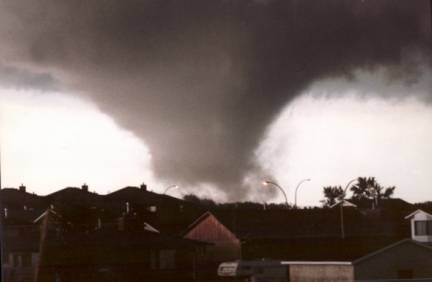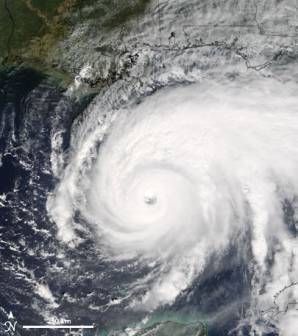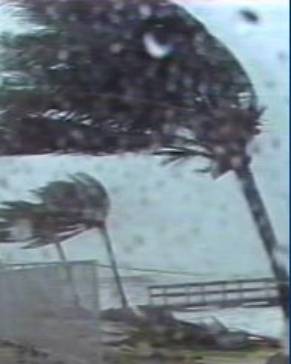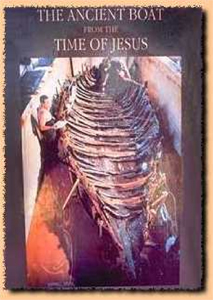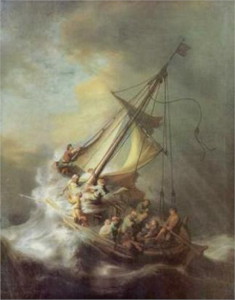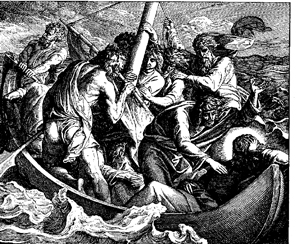
Christmas
Easter
Pentcoest
All Saints
Christ The King
Confirmation
Palm/Passion
Reformation
Stewardship
Books of the Bible
Lenten Series
Christmas Dramas
Videos
Series A - Matthew
Series B - Mark
Series C - Luke
Series D - Other
To contact
Edward F. Markquart
info@sfs.com

Pentecost 4 Mark 4:35-41 Tornado time. Tornado time back there in the Midwest. In Minnesota, South Dakota, North Dakota and Iowa. It is that time of year when tornadoes are all around. The sirens scream out their warnings and you are not sure if your little house will protect you. I remember all those tornadoes when I was growing up, those black funneled clouds that would come blowing across the plains. I remember them blasting barns and obliterating houses and thrashing all the leaves from all the trees. The tornado was somewhat like a lawn mower. You know when you take your lawn mower through your lawn. It just cuts down all the grass. When a tornado hits the land, it just cuts down everything in its path. I will never forget one tornado. It was a great one. We were visting Grandma and Grandpa at their house in St. Paul, Minnesota. My children were young and were not really used to tornadoes, having grown up here in the Pacific Northwest. We were at Grandma’s brick house, on the second floor, near the attic, looking out the small window at the end of the hallway. The wind was howling, the lightning was crackling, the thunder was rumbling, and we were on the top floor of Grandma’s house and not in the basement so we could hear it all really well and see it really well. We were in the middle of that electrifying storm. You would continue to peak out the window and every time the lightning would crack, it would light up the sky. As the light lit up the sky, you could see the trees bending over and the rain coming down in sheets. You could only see it when the lightning would flash. It was a frightening storm. And then the tornado sirens would start to wail. Our kids from here in the safe Northwest had never seen nor heard anything like that before, and they were petrified. You would then turn on the radio and listen to the “tornado watch.” The radio would say that the tornado was thirty miles west of the Twin Cities, near Minnetonka, moving directly east at forty five miles per hour.” And I would say to the kids, “Kids, it’s time to go down into the basement where it is safe. You would go down to the basement just as the lights went out. The electricity was out. You light the candles. You bring out the flashlights. You listen to the portable radio. You hear the wind howling outside, and you know that you are in the middle of the storm and the wind is in your neighborhood. Slowly, slowly the storm goes by. The sirens stop their wailing and the electricity comes back on and the lights come on. You come upstairs out of the basement. You turn on the TV and you see pictures of block after block after block of homes that have been leveled by the storm, just like lawnmower cuts a swatch through the lawn, so the tornado cuts a swath through the city. Down in Florida, they don’t experience tornadoes but their variety of storms are called hurricanes. You remember the pictures well. You know about the hurricane named Rita.
Down on the ground, you see the wind whipping the trees: The gospel story for today is a tornado story. What tornadoes are to Minnesota and hurricanes are to Florida, are what wind squalls are to the Sea of Galilee in the land of Israel. If Minnesotans are afraid of tornadoes and if Floridians are afraid of hurricanes, the people who live on and near the Sea of Galilee were afraid of wind squalls that came suddenly, with no warning, onto the Sea of Galilee with devastating power. The Sea of Galilee is six hundred feet below sea level. It is a body of water ten miles long and four miles wide and there are deep crevasses that come down into it from the east side. The winds come off that desert plateau above the lake and drop suddenly down into the lake and become a nasty wind squall that can suddenly create enormous waves. One day, Jesus was out in the boat on the Sea of Galilee. You can see a picture of an archeological exhibit of a boat from the bottom of the Sea of Galilee in Jesus’ day.
This boat from 2000 years ago was 26 feet long, seven feet wide and carried fifteen fisherman. Jesus and his disciples were out in a boat, perhaps similar to this one. Fragments of other boats near this boat indicated that this was an area that may have been a shipyard. The remnant of the boat was found during a prolonged drought in 1986 and consequently the water in the lake was low. Jesus was out there with his closest friends, Peter, James and John, plus the other disciples. The boat was large enough to handle all of them. His three friends were experienced fishermen and they knew the mood of the water, its ugliness and its surliness. According to the Biblical story today, they were out there with several other boats. Jesus had become famous and so when he got into a boat and sailed out into the Sea of Galilee, everybody got into their boats and followed him, just as crowds today follow famous people. They were all out there in the middle of the Sea of Galilee when suddenly, like a tornado in Minnesota, like a hurricane in Florida, along came this wind squall from the east side of the lake, down through the crevasses, down through the gullies. The waves can be suddenly five to six feet tall. A vicious storm hit and the waves started to get really big and the waves started coming over the side of the boat. These were experienced fishermen and they knew that his was panic time. The famous artist, Rembrandt, captures the scene. You can see and feel the storm.
And what was Jesus doing? What was Jesus doing in this panic moment? The text says that he was sleeping, sleeping in the stern of the boat. The text gives the detail that he was sleeping in the stern of the boat. The text gives the other detail that a pillow was under his head and he was sleeping away. Examine the next painting. It is my favorite of this scene.
Notice the muscular fishermen fighting for their lives. Notice the numerous details in this painting: the detail of Jesus sleeping in the stern of the boat, the detail of his head on a cushion/pillow, the detail of a disciple approaching Jesus with his hand extended and ready to touch his shoulder and wake him up, the detail of the waves lapping over the side of the boat. These details are all in the Biblical narrative. (The preacher may not want to mention one detail that the artist got wrong: Jesus is in the bow of the boat while a muscular fisherman is in the stern of the boat, attempting to steer it in heavy winds.) The disciples were afraid. They were experienced fishermen who weren’t easily frightened by storms but this storm was nasty enough to make them afraid. They grabbed Jesus’ shirt and shouted, “Jesus, wake up.” They spoke that classic line from Biblical literature when they said, “Don’t you care? Don’t you care that we are perishing in this storm?” was their accusation against him. That question, "Don't you care that we are perishing in the storm?" has echoed down through the centuries. Jesus woke up and said to the storm, “Be quiet. Be still.” As if he were casting out a demon. Like when Jesus cast out demons from people, he had said, “Be quiet. Be still,” and Jesus quieted the storm inside of people. But now Jesus was quieting the storm on the lake. Suddenly, it was very calm and Jesus turned to his disciples and asked, “Why are you so afraid? Why are you so afraid of the storms of life? Don’t you have faith? Don’t you trust that I am with you during the storms of life? Where is your faith?” And Jesus' question as also echoed down through the centuries, "Why do you have so little faith in the midst of the storms of life?" And the disciples became quiet because they had not seen anything like this before. That somebody controlled the winds and the waves. They believed that he was the Son of God. And thus ends a great story, one of those great eyewitness stories. Simon Peter must have been the one to have told this personal story. Simon Peter knew this story because he was there, on the scene, on the lake, in the squall. He knew this story well. The painting of Jesus asleep in the stern of the boat will be left on the screen for the duration of the sermon. This picture is a dynamic recreation of that event. According to an early church father by the name of Papias, in the year 112 CE, the Gospel of Mark are the reminiscences of Simon Peter before he died in Rome in about the year 65 CE. Peter told his secretary, John Mark, the stories of Jesus’ life just before Peter died in Rome and that is how we got our Gospel of Mark. Simon Peter gave his dictations to John Mark who we know as Mark and thereby we get the Gospel of Mark. The story for today is an eyewitness account and so from Peter, we get numerous colorful details of the story such as Jesus asleep in the stern of the boat, Jesus’ head on a pillow, the experienced salty fishermen being intensely afraid of the suddenly wind squall, that many other boats were nearby on the lake. This is a story which is rich with meaning. There are so many ways that this story applies to us. There is so much truth that can be unlocked in this little miracle story. Where to begin? This story for today is an invitation for us to trust God. To trust God not merely when life is good, in the the good times when we have plenty of health, cash and family around. But to trust God in the midst of the storms of life. The disciples did not realize that the power and presence of God was with them during their storm. They could have simply trusted God, trusted that God was with them. In this text, we are invited to trust God, especially during our own personal storms of life. You see, life as we know it is filled with storms. Do you ever watch the weather man on television and there is that radar scope that goes round and round and it goes “beep, beep, beep, beep” and it shows you where the storms are? If you put a radar on the globe Earth and you see and hear these beeping signals all over the Earth where nasty storms are going on right now. I am not talking simply about nasty weather storms like hurricanes and earthquakes which kill people by the thousands but wars, ethnic conflicts and starvation. The radar goes over Africa, over the Sudan where hundreds of thousand are living in refugee camps, and the radar goes “beep, beep, beep, beep.” Or years ago in Africa, it was Rwanda. The front page of Time Magazine said that “All the devils have left hell and gone to Rwanda.” The radar screen was going “beep, beep, beep, beep” over the hells in Rwanda during its genocide. Storm center. Storm center. Storm center. Or you go to Haiti as thousands of people were in rickety boats trying to get to the United States and the radar screen goes "beep, beep, beep." You go to Guatemala after the devastating floods and the radar screen goes “beep, beep, beep, beep.” You go to Mississippi after the hurricanes and the radar goes “beep, beep, beep, beep.” You go to Iraq in the middle of this war and the radar goes “beep, beep, beep, beep.” We know that life is just filled with storms. You don’t have to go to all those places like Sudan, Haiti, Guatemala, Mississippi or Iraq, but you can stay be at home and the storms are part of your life and mine. Cancer. Heart attacks. Suddenunemployment. Marriages falling apart. Storm centers are right here in our own back yard. A few weeks ago, Sandy was at a congregational picnic. She went to see a doctor. Pancreatic cancer. It was like a sudden squall hit her life and actually destroyed her in weeks. Or when Sharon called about her son in law, young, forty years old, attorney, died on the spot with a heart attack, leaving his wife and three young kids. Recently, there was a car accident and one of your loved ones was killed instantly. We live in a storm center and the storms strike so suddenly. You don’t need to go to Haiti. You don’t need to go to the Sudan. You don’t need to go to Iraq. You can stay right here and you will find the sudden storms squalling around your life. The devils are here. The storm centers are here. Storms centers are at the very heart of all of our lives. In the midst of all the storms of life, when the powers of Satan are all around us, our intuitive instinct is to be afraid. It is to have a panic attack. It is to ask God, “Don’t you care?” Or to say, “God, are you there at all? Are you sleeping on the job?” Into those situations, Jesus asks a profound question, “Why are you afraid?” “Why aren’t you trusting?” “Why are you so afraid of the storms of life?”
Is there ever going to be a time in life where there are not storms? Is life created in such a way that you and I are to be immune and insulated from the storms of life? Have you ever lived in Minnesota during the summer when there were not tornadoes? I am here to tell you that there are always tornadoes in Minnesota during every summer time. And there are always tornadoes in our lives. Jesus asked the question, “Why are you so afraid of storms of life?” There will always be storms and I will be there with you. I will be there to strengthen you and to care for you. The Biblical text for today is a call for us to trust God in the midst of the storms of life and to know that God will catch us whether we are sick or dying or afraid (referring to the children’s sermon which was earlier in the service) like the little children were caught. To know that God will ALWAYS catch us and will never let us splat on the ground. I like that song by Sister Maria Teresa, JOY IS LIKE THE RAIN. The line from that song that I like the best is this one: “Christ asleep within my boat, whipped by wind but still afloat, life is tried by storm.” Whipped by wind but still afloat!!! What a strong and positive attitude. Another illustration of this. In 1542, there was a plague in Germany. Martin Luther’s little girl, Magdalene, was dying of the plague. So many children and adults were dying of that same plague at that same time. This was Luther’s second child who was dying. His little Elizabeth had already died just the year before. Martin Luther had just lost two little children to the plague and he wrote (in his Tabletalks): “When his daughter was placed into the coffin, Martin Luther said, ‘My dear little Lena. How well it turned out for you. My dear little child, to think that you will be raised up and will shine like the stars. Yes, you will shine like the sun. The coffin cannot hold her. That little bed is too small for her.’ And when the people came to him at the funeral and spoke to him as was their custom, they expressed their sympathy to him. And Luther said, “You should be pleased. I have sent another saint to heaven. Two saints to heaven. Magdalene and Elizabeth.” Are Luther's words simply a reflection of naive attitudes from centuries ago or is there a truth to his wisdom? To trust. To trust God with a child’s life that when the child dies, the child will not fall spat onto the ground but will be caught by the loving hands of her heavenly Father. To trust in the storms of life. Whether we are sick or diseased or dying, to trust God. This is what the text is all about. Life is filled with tornadoes. Life is filled with tragedies. It is always tornado time. But Jesus asked the question, “Don’t you trust me? Don’t you trust me?” There is no promise that we will be spared from the storms of life. There is no promise that we will be free from tornadoes. There is no promise that we will be freed from the little storms of life nor the big storms of life, but God did promise, “I will be with you.” Christ asleep within my boat, whipped by wind but still afloat. Life is tried by storms.” But there is more. There is more that needs to be said. We need to address that classic line from the text, “Don’t you care God?” I think of Albert Schweitzer who was a medical missionary in Africa during the last century. He had been there for forty years. Dr. Schweitzer had worked for twenty four hours a day, seven days a week and he was totally exhausted. One day he was sleeping on the porch and a person came in to him and said, “I am sick. Wake up, Dr. Schweitzer. Don’t you care?” Dr. Schweitzer had spent his whole life caring for people, day and night for forty years, and the patient cried out to him when he was taking a nap, “Don’t you care?” What an absurd question. Likewise, to say to Jesus of Nazareth who was the very presence of God here on this earth, who had come out of the safety of heaven and come down to earth with all of its misery, who had been with human being in all their pain and who himself went to the cross to die on our behalf, and to say to Jesus, “Don’t you care?” It seems to miss the mark. What nonsense. What absolute nonsense. In the midst of our sorrow and pain, God could have chosen to remain up in the safety and shelter of heaven but God came down to earth to be with us in all of our misery. We ask, “Don’t you care?” And the story of Jesus is how God has cared so very much. One of the most important people in my life was Dr. Alvin Rogness, who was the president of Luther Seminary in St. Paul when I attended there. He was a prince of a human being. If a human being can be a prince, Dr. Rogness was a prince of a man. There was a royal stature to his life that I have rarely seen in the lives of other people. Dr. Rogness was a prince of a man. He was one of the most gracious and wise men that I have ever known. Dr. Rogness wrote several books but one of his most famous devotional books is entitled, HE WAS ONLY TWENTY FOUR. When his son, Paul, who was only twenty four, the Oxford scholar, his oldest boy, came back from England and got off the bus in Minneapolis, he was hit by a car and killed instantly. Dr. Rogness wrote this devotional called, HE WAS ONLY TWENTY FOUR. He wrote, “Life doesn’t begin when you are old. My son was only twenty four and he was living life to the fullest.” In that book, Dr. Rogness also had a chapter called STORM CENTERS. He wrotethe following words, “You and I are built for storms. We are not built for cozy, safe little harbors. The Lord is with us. With him, we have the kind of craft that can weather any storm. In fact, we should head out for the storms. One of the great perils that faces the church in our day is that we will steer people out of the storm centers. We are not to anchor our lives in some sheltered cove and let the storm tossed world go by. The Lord’s call is not like that. Not to an easier task but a greater cause. Not to peace but to battle. Not to a cozy harbor but to the sea of storms. We are not built for safe harbors. We are built for storms.” Dr. Rogness' words are true: We are built for storms.Amen. CHILDREN’S SERMON Have a step ladder for a prop. Ask the children to come up. Ask for volunteers to climb up the step ladder. Do a sermon on trust but with variations. That is, ask the first child to trust and jump off the ladder and to my arms. As a parent or any loving person, they would not let the child splat onto the ground. …Pause and say to that first child, if you were not very nice and were kind of mean, would I let you splat onto the ground? Of course, I would catch you even if you were mean and nasty. …Ask a second child to volunteer and be near the top of the step ladder. Ask the second child, if you were sick, would I let you splat on the ground and not catch you? Of course not. The child jumps. …Ask a third child to volunteer and be near the top of the step ladder. Ask the third child if you were dying, would I let you splat on the ground and not catch you? Would I let you fall waaaaaay down into the grave? Of course not. The child jumps and is caught. …Ask a fourth child. Same story. What if you are really afraid of heights or just plain afraid that God won’t catch you, will God? Yes. Faith is to trust that God will catch you in all circumstances. |
